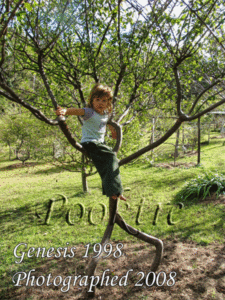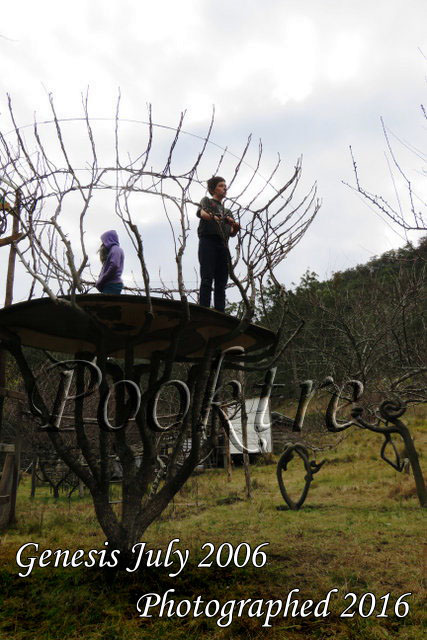 One of the joys of childhood is climbing trees. And that is why our platform trees and tree houses arouse such interest around the world. While putting the video together of teaching our son how to train the banister rail for one of our platform trees, I got to thinking about how we (Pete and I) started with creating living infrastructures.
One of the joys of childhood is climbing trees. And that is why our platform trees and tree houses arouse such interest around the world. While putting the video together of teaching our son how to train the banister rail for one of our platform trees, I got to thinking about how we (Pete and I) started with creating living infrastructures.
Inspiration
We designed and planned out the platform trees by early 2006. Part of the inspiration for doing the platform trees came from our 13-day trip to Japan. We were in Japan to visit the display of eight of our art pieces at the World Expo in March 2005. We had many ideas from that trip of different living infrastructures that we could create. We had been growing and shaping trees for about 20 years at that stage.
It was an exciting time for us, as it was dawning on us the different areas of tree shaping to branch out into. We knew early in 2006 that we would be having visitors who would love to get the jump on us if we showed our hand too soon about the platform trees. So we had to wait till they left to start the first major step. Which was the pruning of the trees to get them ready for the shaping of the branches. To grow the space where the deck would be built inside the shaped branches of the new growth.
One of our visitors, Richard Reames, was staying with us in Australia. He is a cool dude to talk to. And while Richard’s method of shaping trees is more about bending mature branches, we tried to explain why that is a bad idea. It was great to have another person who was interested in the field of tree shaping to talk to. We explained many of our various ideas about training trees. We explained to Richard Reames our concept of platform/deck trees. Luckily for us, I think we overshared with him and it seems he didn’t remember most of what we told him.
Shaping and Tree species
So as soon as our visitors were on the road home, we jumped right into training our trees. When it comes to trees, we don’t mess around. We literally live for this stuff. It was our winter of 2006, and we worked with four different tree species at the start of creating our first platform trees.
We found out that the species of oak tree we had at home in Australia hated being pruned. The pear tree was easy to shape, but it is a spongy tree with almost no muscle wood. We were not very inspired to add the platform/deck to it because the pear was so short in height. The resulting deck would have only been at chest height. The silver lining is that the shaping of the pear gave us the realisation that any of the trees used with espalier would also work well with the pooktre process of shaping trees.
The Nashi pear tree and plumcot tree were close in height. Their decks are just over two meters off the ground. While the training of all the trees was via the pooktre process, we did two different looks with Nashi and Plumcot trees. The Nashi pear has a more even and planned look with double rails. whereas the plumcot has more of a free-form look.
Work unseen
Like all of our tree shaping, it’s in the early years where the bulk of the work and training is done and people don’t notice. It’s the work that goes unseen that results in the even and flowing forms of pooktre. It’s not till they gain in girth and get their visual weight that people notice them. People couldn’t understand what we were talking about with the platform trees. Only once the decks were added did people notice them.
Knowing that there are many different species of trees that have the potential to be trained across the world with tree shaping. We envisioned that by creating living infrastructure with trees, it could lead to a new type of ecosystem, one where humans and nature work together.
Trees can easily incorporate a vast array of different materials and, as such, with designing and planning, can become a large part of the infrastructure of our city’s streets around the world. It would be a great way to mitigate the effects of climate change on the environment.
From small things, big things grow

Pete and I are very creative people who have been acknowledged as world leaders in this art form of shaping trees. We have a vast range of knowledge about successfully shaping trees and how they can be used in urban environments. Our biggest issue now is where to go from here. We have a major piece of the puzzle.
We think it’s very important to collaborate with other people who are thinking in the same way, and who see the value in living art. The types of people who could have a large impact on the path forward are the organizers, marketers, forward-thinking visionaries, and anyone else who sees the value in this type of art.
Let’s Grow together
We don’t have all the pieces of the puzzle, and this is not a very well-known art form. We would love for you, our readers, to help us find out how we can bring attention to this art form and create a better and more sustainable future for us all. You can contact us at enquiries@pooktre.com or on social media via a search for “pooktre”.

